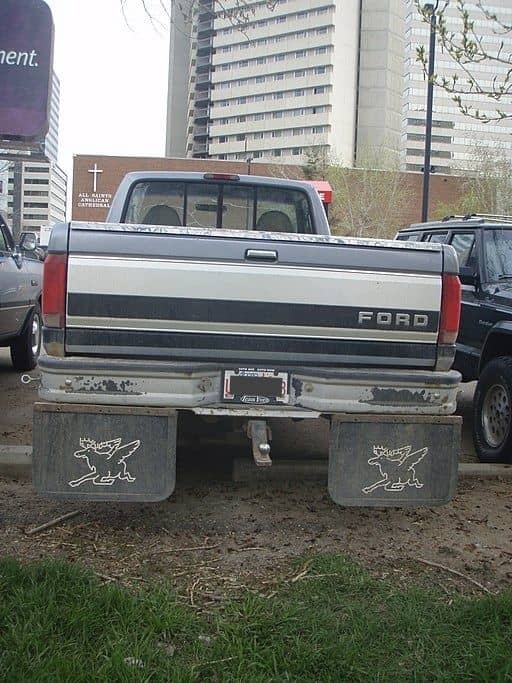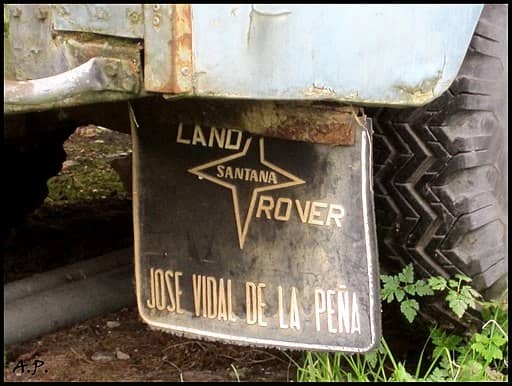When traversing through any terrain in an automobile, the tires of the vehicle press down on the ground flinging the dirt, gravel and or snow in the various directions.
This debris acts as a projectile sitting on the fender well of the vehicle continuously and repeatedly. The constant action of debris on the fender of a vehicle causes the slow and gradual deterioration of the inner parts of the fender.
If left unchecked, it may result in very costly repairs to the paint job as well as corrosion of various parts. For this reason, the use of a mud flap or splash guard is employed to counter this problem.
Mud flaps are indeed useful in their operation, but they cause drag as a result of the created air resistance when the vehicle is in motion. The amount of drag caused by mud flaps is quite small and its effect on the gas mileage is negligible.

Mud Flaps and Drag
Drag in the automobile industry is a big issue. It is the force that acts in the opposite direction of the direction of motion of the vehicle, and in the same direction of airflow, which slows the vehicle down due to air resistance.
More power is required in overcoming drag and hence you should always aim to minimize it. Adding a mud flap to an automobile increases the air resistance around the wheel. It blocks the streamlines passing through the wheel creating Eddy currents which could lead to a need for more power in pushing through the air.
The more power needed leads to higher fuel consumption which in turn affects the average mile per gallon (mpg) or kilometers per liter readings.
Also, drag increases exponentially when speed is proportionally increased. To be more specific, drag increases with the square of the speed. Hence, it is critical to keep the drag coefficient low at low speeds but as low as possible at high speeds.
Though mud flaps cause resistance, they are small in nature and their location will not significantly affect the overall miles per gallon. If so, it will be quite negligible.
Are Other Mud Flaps Better For Drag?
Yes, there are new types of vented mud flaps that have holes in the design to allow for air to pass through.
The louver style mud flaps reduce air resistance by allowing air to pass through but still retaining all the qualities of a normal mud flap.
They are mostly fitted on large trucks and SUVs which average quite low on the mile per gallon naturally. Hence it has to be converted in all possible areas to improve on the fuel economy.
What Are Mud Flaps?
A mud flap or mud guard is a large flap made of various materials located at the back and underside of a tire.
The main reason for putting a mud flap in place is to protect the inner side of the fender lining from the flying debris thrown at high speeds from the rubble picked up by the tires.
A mud flap is considered as an accessory because not all vehicles come fitted with them from stock, but rather bought and fixed on after market. However, most of the larger trucks and SUVs are fitted with them straight from the factory.

Uses of Mud Flaps
- A mud flap safeguards the undercarriage of a vehicle from the fast-moving dirt and grime which may cause dents not only to the vehicle but to your wallet.
- It also protects the passengers inside the cabin from being hit by any flying dirt while moving on the roads. Of course, the truck windows must be open for anyone to get hit by debris.
- Also, without mudguards, all vehicles behind you will undoubtedly receive showers of gravel and mud on to the bumper and even windshield. This can cause visibility impairment and may lead to a rear-end collision.
- The dirt and gravel shoved back can cause serious damage to the car tailing you especially if the terrain is rugged. This will lead to hefty settlements as car parts are not all that cheap.
- During the snowy season, mud flaps also come in handy in preventing snow buildup on side steps, running boards, and fenders. The salt and snow mixture tends to adhere to the mudguard instead, making it easier for the vehicle to move.
- The abrasive nature of grime and stones can damage the paint job on and under the carriage of the car. Once the paint is removed, the bare-metal gets exposed to environmental factors like oxygen and water which is a recipe for rust. To deal with corrosion is an expensive affair and, if possible, should be prevented instead of spending time and money to fix it.
- Mud flaps are also useful when towing property. When towing a boat or a trailer, you would not want it to get pelted with rubble as it would potentially damage your expensive property. Adding mud flaps to your truck would greatly reduce this from occurring.
Types of Mud Flaps
There are a variety of mud flaps available on the market. They are mainly differentiated by their material type, size, and use.
Rubber
Rubber is a more flexible type of mud flap as it can bend and move about easily. It is very effective in stopping flying debris.
Soft rubber is galvanized to make it more strong and durable. This is to make it last in any harsh conditions because it is usually subject to the surrounding temperature i.e if it is too hot, it becomes soft and if it is cold, it becomes hard.
Rubber mud flaps are relatively cheap with low maintenance costs as they are just occasionally cleaned or replaced if damaged or cracked.
They are fitted to the back of the wheel well through pre-drilled holes and nuts so it is easy to fit them in. If they are not already drilled, you could do it yourself but I would recommend getting a professional to do it if you lack the experience.
This type of mud flap can hang low and even graze the road surface without much problem as it is flexible.
Plastic/Polymer Composites
Plastic is more resistant to bend as compared to its rubber counterpart. Due to the hard thermoplastic properties, it is often used because it can take heavy hits and protect the vehicle while still looking undamaged.
An upside to using plastic is that it can stop large projectiles with ease, which would otherwise be unhindered by rubber mud flaps.
Though this type of mudguard has its upsides, it has its downsides as well. Plastic is brittle and can break if put under too much stress. And like rubber, it can stretch under stress.
Another downside is that it cannot be hung low because contact with the road surface during movement will lead to automatic mud flap breakage and possible damage to your wheel well.
Metal
These are the strongest and most rigid types of mud flaps.
They are mostly made out of sturdy stainless steel because of their natural ability to resist corrosion. Stainless steel mud flaps can withstand constant impact with flying debris and grime, no matter the size or quantity.
Another such material used is aluminum, which is light and inexpensive to acquire and machine. They are desirable when going on harsh terrain. In the event of a massive dent or crack, the whole flap can be removed and replaced without costing too much out of pocket.
Universal Flaps
These are the types of flaps tailored by factories to fit almost any vehicle from sedans, pickup trucks, SUVs, and even heavy machinery.
They can be swapped out and installed from an old vehicle to a new one with ease and without compromising effectiveness.
They can be made from either rubber, plastic, metal or a combination of all three.
Hitch Mount Mud Flap
These are the most robust types of mud flaps used on the market. They can only be attached to vehicles via hitch mounts. You would not attach them to wheels wells.
They are extremely wide and are set to hang really low and further toward the rear to capture all the dirt being flung back.
The material used (rubber, plastic or both) is close to half an inch thick making it really reliable in stopping any size of debris. I would not recommend them on sedans or smart cars for obvious reasons.
You would use these when towing trailers and boats as they would provide the maximum protection against all types of debris. They are also the best option for dually or lifted trucks as you can get them wider and longer if needed.
Mud Flaps Pros
- A person gets to protect their own vehicle from rust and corrosion.
- Protection of other vehicles and traffic within close proximity while on the road.
- Mudflaps are designed well and fitted perfectly to a vehicle to improve the overall aesthetics of the car.
- Mudflaps are relatively cheap and easy to install.
Mud Flaps Cons
- Improper installation may lead to it falling off or getting stuck within the wheel.
- The plastic-type mud flap is more prone to breaking because of its rigidity in contrast with the rubber type
- It causes minimal aerodynamic drag.
- Constant repair and replacement may be expensive depending on the specific mud flap.
Conclusion
Mudflaps are an invention that has such a subtle but meaningful impact on the automobile industry.
Mud flaps have significant roles to play in preventing damage to one’s own car and those of others. They are, without a doubt, one of the most important accessories you could add on, not only for aesthetic purposes but for functionality as well.
Its ability to cause a slight amount of drag is negated by its usefulness and vehicle protection capabilities.
If you’re thinking of different ways to accessorize your truck or make it more functional, consider checking out my recommended accessories page. I spent a good amount of time picking out mods that can be useful for most pickup trucks.

